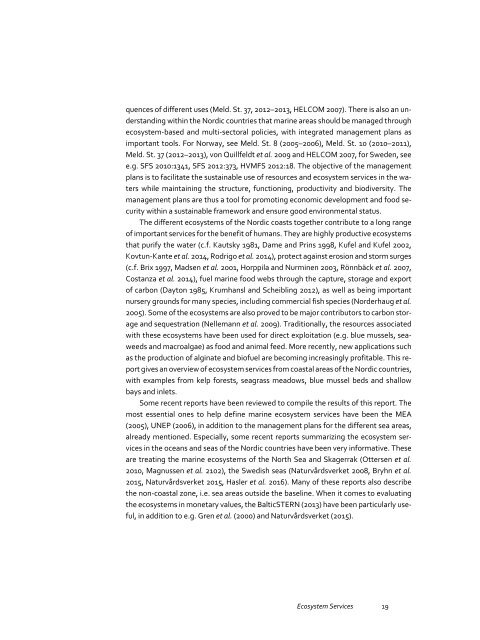Ecosystem Services
FULLTEXT01
FULLTEXT01
You also want an ePaper? Increase the reach of your titles
YUMPU automatically turns print PDFs into web optimized ePapers that Google loves.
quences of different uses (Meld. St. 37, 2012–2013, HELCOM 2007). There is also an understanding<br />
within the Nordic countries that marine areas should be managed through<br />
ecosystem-based and multi-sectoral policies, with integrated management plans as<br />
important tools. For Norway, see Meld. St. 8 (2005–2006), Meld. St. 10 (2010–2011),<br />
Meld. St. 37 (2012–2013), von Quillfeldt et al. 2009 and HELCOM 2007, for Sweden, see<br />
e.g. SFS 2010:1341, SFS 2012:373, HVMFS 2012:18. The objective of the management<br />
plans is to facilitate the sustainable use of resources and ecosystem services in the waters<br />
while maintaining the structure, functioning, productivity and biodiversity. The<br />
management plans are thus a tool for promoting economic development and food security<br />
within a sustainable framework and ensure good environmental status.<br />
The different ecosystems of the Nordic coasts together contribute to a long range<br />
of important services for the benefit of humans. They are highly productive ecosystems<br />
that purify the water (c.f. Kautsky 1981, Dame and Prins 1998, Kufel and Kufel 2002,<br />
Kovtun-Kante et al. 2014, Rodrigo et al. 2014), protect against erosion and storm surges<br />
(c.f. Brix 1997, Madsen et al. 2001, Horppila and Nurminen 2003, Rönnbäck et al. 2007,<br />
Costanza et al. 2014), fuel marine food webs through the capture, storage and export<br />
of carbon (Dayton 1985, Krumhansl and Scheibling 2012), as well as being important<br />
nursery grounds for many species, including commercial fish species (Norderhaug et al.<br />
2005). Some of the ecosystems are also proved to be major contributors to carbon storage<br />
and sequestration (Nellemann et al. 2009). Traditionally, the resources associated<br />
with these ecosystems have been used for direct exploitation (e.g. blue mussels, seaweeds<br />
and macroalgae) as food and animal feed. More recently, new applications such<br />
as the production of alginate and biofuel are becoming increasingly profitable. This report<br />
gives an overview of ecosystem services from coastal areas of the Nordic countries,<br />
with examples from kelp forests, seagrass meadows, blue mussel beds and shallow<br />
bays and inlets.<br />
Some recent reports have been reviewed to compile the results of this report. The<br />
most essential ones to help define marine ecosystem services have been the MEA<br />
(2005), UNEP (2006), in addition to the management plans for the different sea areas,<br />
already mentioned. Especially, some recent reports summarizing the ecosystem services<br />
in the oceans and seas of the Nordic countries have been very informative. These<br />
are treating the marine ecosystems of the North Sea and Skagerrak (Ottersen et al.<br />
2010, Magnussen et al. 2102), the Swedish seas (Naturvårdsverket 2008, Bryhn et al.<br />
2015, Naturvårdsverket 2015, Hasler et al. 2016). Many of these reports also describe<br />
the non-coastal zone, i.e. sea areas outside the baseline. When it comes to evaluating<br />
the ecosystems in monetary values, the BalticSTERN (2013) have been particularly useful,<br />
in addition to e.g. Gren et al. (2000) and Naturvårdsverket (2015).<br />
<strong>Ecosystem</strong> <strong>Services</strong> 19


